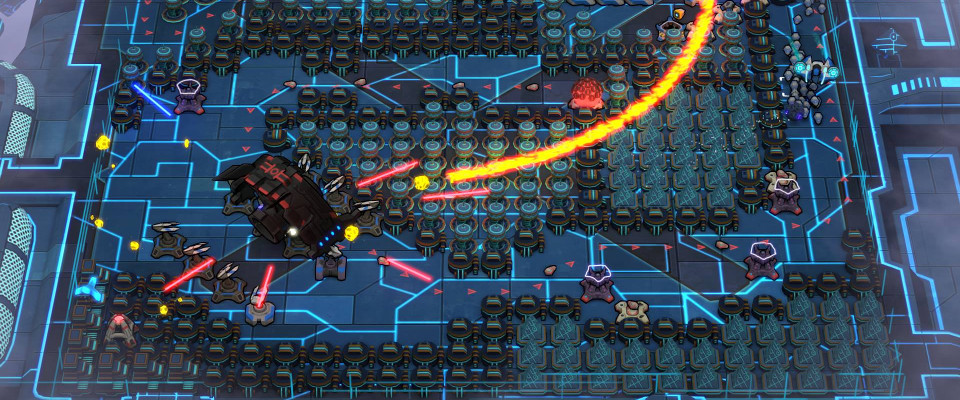Tower defense is a relatively unique genre. Having spawned from a mod for Warcraft 3 what seems like a gaming-millennium ago, it has since occupied its own little niche, while occasionally finding its way into bigger games. Comet Crash takes the genre and moves it closer to a real time strategy, as it has you creating your own units to send against the enemy’s own defended base as well.
There are two schools of tower defense, one in which enemies take a specific route towards your base around which are designated places for you to place defenses (such as Defense Grid), where the choice of towers is the focus. The second allows towers to be placed wherever you like and the route enemies take will adapt, allowing the player to create long, maze-like paths through weaponry (such as Desktop Tower Defense).
Comet Crash marries these two approaches, featuring levels with wide open areas as well as those with more limited placement available, and plenty somewhere in between. The combination ensures you have to adapt your tactics for each level, rather than settling into a rhythm of creating the same type of defense each level.
You control a diminutive spaceship when placing your buildings, which cost Thorium to build, upgrade and repair. Thorium is collected from asteroids that will randomly float around the map and must be blown up by dragging it over to your towers or dropped them into the harvester building which will do it for you. You will want to watch when you’re collecting them from near enemy towers though, as they can shoot you down, causing you to lose a little time while you wait a few seconds to respawn.
Other than the usual types of towers, such as turrets, lasers, or cannons there are also other buildings that can be placed. Basic Ops, for example, creates units for you to send forth and give your opponent a taste of its own medicine, whereas the Gateway will allow your units through but not an enemy’s, so you can create shortcuts. Buildings can also be upgraded, allowing towers to deal more damage or shoot more often, while other buildings will acquire increasingly useful units, such as a tank for Basic Ops that is tougher, but slower.
As you play through the campaign, you will unlock new units at a steady pace, usually after fighting an enemy that uses them. Having your own units opens a few possibilities for situations that, in any normal tower defense, would spell your demise. A large group of enemies that could make it through your defenses will struggle if you release the Hammers, a unit made by the Special Ops building that slows nearby enemies down to a crawl, giving your towers more time to finish them off.
Sick of all the Pulsar towers in your enemy’s base? Send in the Switch and it will deactivate any Pulsar that hits it for a short time, letting your hopefully well-timed units stroll right through the defenses. Alternatively, place your own towers nearby to destroy them, then replace them before the AI does and you can take over the entire base if you are patient enough. Alternatively you could make 200 tanks and send them all at once while you pretend you’re the Flood from Halo.
Then there are giant enemies that spawn into specific levels that, upon destruction, allow you to store more Zoids. A Zoid is harvested from non-Thorium asteroids and can be used to give a tower or certain other buildings a boost, so it will shoot or create units considerably more quickly. Useful, though you will have to juggle the boss and the regular enemies on the level, so it can be a little awkward.
Fine tuning a maze that decimates any enemies, regardless of number, is very satisfying, as is using Hammers to slow an enemy army to a crawl. Timing it so your various units (each of which move at different speeds) all arrive at the enemy’s base at once, deactivating Pulsars and overwhelming them is just as fulfilling.
Of course, the AI will do the same thing to you, so relying too much on a specific tower can result in your undoing. The wealth of options available really adds purpose to the game. Rather than just waiting for waves of enemies to fall at your towers you’re also creating your own waves against an opponent that can adapt. It is satisfying to a degree that many other tower defense games can’t quite reach, as you win, rather than just outlasting some waves from an indistinct opponent.
There is also competitive and cooperative multiplayer to sink your teeth into, both locally and online. Unfortunately, I haven’t been able to get into an online match, even over a double XP weekend, which is not a good sign so soon after release.
What’s Good:
- Units and resources add significant depth.
- Drip feed of new units keeps things fresh.
- Level variety.
- Graphics are sharp and clear…
What’s Bad:
- …but not impressive.
- Sparsely populated multiplayer.
- Menus could be better.
Comet Crash 2 is a uniquely well designed game. It stirs just enough resource gathering and unit management to add depth without taking anything away from the tower defense, creating a gameplay with two parts that complement each other strongly. It’s an easy recommendation to fans of either genre.







Tony Cawley
Sounds really good, just my cup of tea. My only problem with these games really is levels often become trial and error, keep going at it until you learn attack patterns for that level and place defences appropriately.
frostface
I completely understand why points are deducted regarding the MP, or lack of being able to get a MP game to connect. It would have been better if the game didn’t offer MP. I would recommend anyone who’s looking to get the game, just think of it as a solo game and you won’t be disappointed. It’s really a fantastic game and imo a must have.